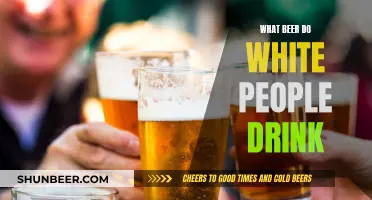
Drinking beer and getting a six-pack are often considered incompatible goals. Beer is known for its high calorie content, with a standard beer containing around 150 calories. Consuming six beers can result in an extra 900 calories per day, leading to potential weight gain and associated health issues such as an increased risk of heart disease, stroke, high blood pressure, and type 2 diabetes. Additionally, alcohol interferes with fat burning as the body prioritizes processing alcohol over burning fat. However, some people argue that drinking in moderation and balancing your calorie intake can allow you to enjoy a beer without completely sacrificing your fitness goals. Choosing low-carb and low-calorie drinks, such as tequila, gin, or vodka, can also help minimize the impact on your physique. Ultimately, achieving a six-pack depends on a combination of maintaining a low body fat percentage and regularly exercising your abdominal muscles.
| Characteristics | Values |
|---|---|
| Alcohol type | Beer |
| Calories | 150 calories per standard beer |
| Calories (six beers) | 900 calories |
| Weight gain | Potential weight gain of up to two pounds a week |
| Health issues | Risk of heart disease, stroke, high blood pressure, type 2 diabetes, liver disease, and cancer |
| Liver function | Can overload the liver, leading to alcohol-induced liver disease |
| Cardiovascular issues | Can lead to hypertension and cardiomyopathy |
| Alcohol dependence | Can lead to increased tolerance and dependence |
| Mental health | Can exacerbate anxiety and depressive disorders |
| Digestive issues | Can cause gastritis, pancreatitis, bloating, gas, diarrhea, and discomfort |
| Calorie adjustment | Adjust daily calorie intake to account for beer calories |
| Alternative drinks | Lower-carb and lower-calorie options, such as spirits |
| Drinking frequency | Limit drinking to one night a week or a couple of drinks |
What You'll Learn

Drinking in moderation
Firstly, it's important to understand what constitutes moderate drinking. According to the Centers for Disease Control and Prevention (CDC), moderate drinking is defined as two standard drinks per day or less for men and one standard drink per day or less for women. A standard drink in the United States is equivalent to 14 grams (0.6 ounces) of pure alcohol, the amount typically found in a 12-ounce beer.
If you're aiming for a six-pack, it's advisable to limit your drinking to one night a week or just a couple of drinks when you go out. This will help you avoid consuming excessive empty calories from alcohol, which can hinder your progress. Additionally, try to choose your drinks wisely. Opt for lower-carb and lower-calorie options, such as spirits like tequila, gin, or vodka, instead of sugary cocktails or high-calorie beers.
It's also crucial to balance your calorie intake. A standard beer contains around 150 calories, and these extra calories can contribute to weight gain and increase the risk of associated health issues. Make sure to adjust your food intake accordingly if you know you'll be drinking, and focus on maintaining your protein levels while reducing carbs and fats.
While it's challenging to completely abstain from drinking, especially when socialising, allowing yourself a drink in moderation can be part of a sustainable, healthy lifestyle. By being mindful of your consumption and understanding the risks associated with heavy drinking, you can strive for a balanced relationship with alcohol that doesn't compromise your fitness goals.
Beer Diet: Does It Work?
You may want to see also

Choosing low-calorie drinks
Alcoholic drinks are often loaded with calories and added sugar, which can contribute to weight gain and health problems in the long term. However, drinking in moderation and choosing low-calorie drinks can help you stay on track with your fitness goals. Here are some tips for choosing low-calorie drinks:
- Opt for spirits: Spirits like tequila, gin, vodka, and whiskey tend to have fewer calories than other types of alcohol. For example, a shot of vodka or rum typically contains around 97 calories.
- Mix with low-calorie beverages: Instead of mixing your spirits with sugary sodas or juices, opt for low-calorie mixers like soda water, diet tonic water, or diet coke. For example, a gin and diet tonic has only about 98 calories.
- Choose light beer: If you enjoy beer, opt for light beers, which often have fewer calories and a lower alcohol content. A 12-ounce pour of light beer typically has around 90 to 100 calories.
- Dilute your drinks: Consider diluting your drinks with seltzer, club soda, or ice to reduce the calorie content. For example, you can make a wine spritzer by mixing wine with seltzer.
- Watch out for sugary mixes: Simple syrups, sugary drink mixers, and fruit juices can significantly increase the calorie count of your drink. Instead, use fresh fruit, herbs, or spices to add flavor to your drinks.
- Be mindful of serving sizes: Keep in mind that the standard serving sizes for beer are 12 ounces, wine are 5 ounces, and liquor are 1.5 ounces.
- Alternate with non-alcoholic drinks: To reduce your overall calorie intake, alternate alcoholic drinks with non-alcoholic beverages like water or seltzer.
- Practice moderation: Finally, remember that moderation is key. Limit your drinking to one night a week or stick to one to three drinks when you go out. This will help you stay within your calorie goals.
By following these tips, you can make more conscious choices about your drink selections and support your fitness journey.
Mixing Mucinex and Beer: Is It Safe?
You may want to see also

Adjusting your diet
Achieving a six-pack requires a combination of dietary adjustments and regular physical activity. Here are some essential tips for adjusting your diet to complement your fitness routine:
Calorie Deficit:
To promote fat loss and support ab definition, creating a calorie deficit is crucial. This means consuming fewer calories than your body requires, forcing it to tap into stored fat for energy. However, be mindful not to reduce calorie intake excessively, as adequate calories are necessary to maintain metabolism and fuel your workouts. Aim for a safe calorie deficit of 500-1000 calories per day to lose approximately 1-2 pounds per week, as recommended by the CDC.
Protein, Carbohydrates, and Healthy Fats:
Ensure your diet includes sufficient protein to support muscle growth and reduce hunger. Opt for lean meats, poultry, fish (especially fatty fish like salmon), low-fat dairy, soy products like tofu and tempeh, and most nuts.
Also, include healthy carbohydrates and fats to provide energy for exercise. Whole grains like oats, barley, and quinoa are excellent sources of fiber and nutrients. Additionally, nuts and seeds offer a perfect balance of fiber, protein, and healthy fats.
Fruits and Vegetables:
Incorporate a variety of fruits and vegetables into your diet. These foods are nutrient-dense, providing antioxidants, fiber, vitamins, and minerals. They aid in weight loss, fat burning, and overall health. Aim for at least 4 servings of vegetables per day, as suggested by research.
Avoid Empty Calories:
Limit or avoid foods with empty calories and low nutritional value, such as sugary drinks, sweets, refined grains, and fried foods. These contribute to weight gain and hinder your progress. Alcohol, in particular, is loaded with empty calories, so if you choose to drink, do so in moderation and opt for lower-calorie options.
Stay Hydrated:
Drink plenty of water throughout the day. Water can increase metabolism, aid in digestion, and promote a feeling of fullness, supporting your weight loss efforts. It is also crucial for hydration during exercise, ensuring your body can perform optimally.
Beer and Jury Duty: What's the Verdict?
You may want to see also

Avoiding binge drinking
Binge drinking is a dangerous and harmful practice that can have serious short- and long-term effects on your health, safety, and overall well-being. Here are some strategies to help you avoid binge drinking:
Understand the Risks
Binge drinking is defined as consuming enough alcohol to raise your blood alcohol concentration to the legal limit of intoxication (0.08 percent in the U.S.) or higher within a 2-hour period. This typically translates to five or more drinks for men and four or more drinks for women. Binge drinking can lead to alcohol poisoning, which can be life-threatening. It also increases your risk of injuries, violence, sexual assault, and accidents, including fatal car crashes. Additionally, binge drinking is associated with negative moods and cognitive problems, such as impaired memory and decision-making abilities. Understanding these risks can be a powerful motivator to avoid binge drinking.
Set Clear Limits
Decide on a specific number of drinks you will allow yourself and stick to it. For example, resolve to have only one or two drinks when going out with friends. Write down this limit, set a reminder on your phone, or tell a trusted friend about your intentions. Drinking can impair your judgment, so having a predetermined limit will help you stay accountable.
Practice Moderation
While complete abstinence from alcohol may be the fastest way to achieve your fitness goals, it is not always realistic or sustainable for everyone. Instead, practice moderation by limiting your drinking to one night a week or having only a couple of drinks when you go out. This will reduce the number of empty calories you consume and lower the amount of dietary fat your body stores.
Choose Your Drinks Wisely
Not all alcoholic drinks are created equal when it comes to calorie content. Opt for lower-carb and lower-calorie options. Spirits like tequila, gin, and vodka are good choices, and red wine, in moderation, has been shown to stop your fat cells from gaining more fat. Avoid drinks that are high in sugar, such as those mixed with sugary sodas, energy drinks, or fruit juices.
Balance Your Calories
Alcohol is full of empty calories. If you know you will be drinking, adjust your food intake during the day to compensate for the additional calories from alcohol. Consider cutting down on carbs and fats, while maintaining your protein intake to preserve muscle mass. This way, you can still enjoy a few drinks without derailing your fitness goals.
Prepare Healthy Meals in Advance
Drinking can lead to poor food choices, especially when drunk or hungover. A good way to avoid binge eating unhealthy food is to prepare healthy meals in advance and store them in your fridge. That way, when you come home from a night out or are recovering the next day, you have nutritious options readily available that won't sabotage your diet.
Change Your Environment
Triggers for binge drinking often include places, people, and events. While working on your drinking habits, consider avoiding bars, parties, or activities that center around excessive drinking. You may also need to limit your contact with specific individuals or groups who encourage alcohol consumption. If you do choose to go out, set a drink limit for yourself and alternate alcoholic drinks with non-alcoholic ones.
Seek Support
Confide in family and friends who support your decision to cut back on drinking. Ideally, choose a support system of individuals who drink little to no alcohol themselves and can help hold you accountable. Consider joining a support group, such as Alcoholics Anonymous (AA), or seek professional help from a therapist if you feel you need additional assistance.
Craft Beer Enthusiasts: Meet the Founders of Ratio Beer Works
You may want to see also

The health implications of heavy drinking
While drinking in moderation is unlikely to cause harm, chronic heavy drinking can have serious health implications. Alcohol is a toxin, and it is the liver's job to flush it out of the body. However, the liver may not be able to keep up if you drink too much too fast, leading to scarring called cirrhosis. Heavy alcohol consumption can also result in alcoholic fatty liver disease, indicating that the liver is not functioning properly.
Heavy drinking can also cause brain and nervous system problems. Alcohol interferes with the brain's communication pathways, affecting mood and behaviour and making it harder to think clearly and move with coordination. It can also cause mental health issues such as depression and dementia, and increase the risk of developing epilepsy.
Additionally, heavy drinking can negatively impact the heart, causing problems such as cardiomyopathy, arrhythmias, and high blood pressure. It is also linked to an increased risk of developing heart disease.
The pancreas is another organ that can be affected by heavy alcohol consumption, leading to the production of toxic substances that can cause pancreatitis, a dangerous inflammation of the pancreas.
Heavy drinking is also associated with an increased risk of developing cancer, particularly of the head, neck, mouth, throat, voice box, esophagus, liver, breast, and intestines.
Furthermore, heavy alcohol consumption can weaken the immune system, making the body more susceptible to diseases such as pneumonia and tuberculosis. It can also interfere with nutrient absorption, leading to vitamin deficiencies and malnourishment.
While it is possible to drink in moderation and maintain a six-pack, heavy drinking can have serious health implications that should not be ignored.
Detox and Drinking: Is Having a Beer Safe?
You may want to see also
Frequently asked questions
It is not advisable to drink beer regularly if you want to get a six-pack. Beer is high in calories and can contribute to weight gain and health issues. However, drinking in moderation and balancing your calorie intake can help you achieve your fitness goals while still enjoying an occasional beer.
Beer is loaded with empty calories, which can put you over your daily limit and hinder fat burning. It can also lead to poor food choices, such as late-night junk food binges, further increasing your calorie intake and hindering your progress.
Yes, some alcoholic drinks are lower in carbs and calories. Spirits like tequila, gin, and vodka are good choices, and a Paleo Margarita is a "clean" option. Red wine, in moderation, has been shown to prevent fat cells from gaining more fat.







